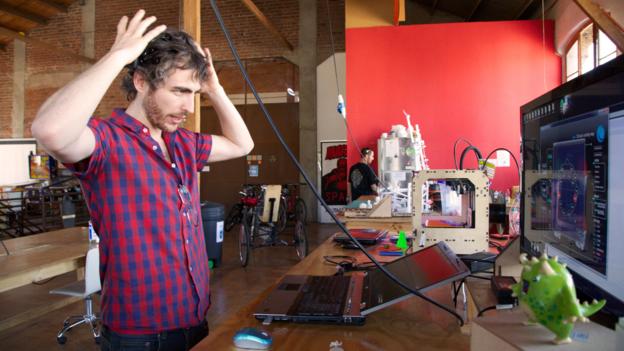Imagine if you could print objects just by thinking about them. Camila
Ruz visits one company to see whether this is far-fetched dream or a
real possibility.
It’s
definitely not a bird. Nor is it a plane. The garish orange piece of
plastic, small enough to hold in the palm of a hand, could pass for a
missing limb of a toy tyrannosaurus. It may not look all that
impressive, but it’s notable for two reasons. One is that the monster
arm has emerged from a 3D printer. The other is that it is, in fact, the
first ever object made from thought.This milestone was reached with little fanfare last month at the Santiago MakerSpace, a technology and design studio in the Chilean capital. The toy limb’s shape was determined according to the wishes of its designer, as gleaned from a headset picking up his brainwaves. The man in question was George Laskowsky, Chief Technical Officer of Thinker Thing, the Chilean start-up developing the mind-controlled 3D printing system.
Engineers and designers have been using 3D printers for more than two decades. More recently, prices have tumbled and desk-top devices are increasingly being pitched at consumers. The touted possibilities appear to be endless – from bones to buildings to burritos – making some observers predict revolutionary consequences like the eventual demise of the factory. Because 3D printers build objects layer by layer from materials such as plastic or metal dust, a key advantage is the comparative freedom they give designers. Yet the design software is not easy to master, especially if you are four-years-old and haven’t yet learnt to hold a pencil properly.
“What is the point of these printers if my son cannot design his own toy?” says Bryan Salt, CEO of Thinker Thing. “I realised that while there were a lot of people talking about the hardware of the printer no-one really seemed to be talking about how to actually use it.” In theory 3D printers could help unleash our inner creativity, freeing us from the constraints of traditional production methods. However, in practice those unwilling or unable to plough through the software instruction manual could be left downloading ready- made models designed by others.
That’s where Emotional Evolutionary Design (EED), the software that allows Thinker Thing to interpret its users’ thoughts, comes in. Its current role is to power the Monster Dreamer Project, which will allow users to design their own fantastical creatures using the power of thought. Chilean children will get the first opportunity to try it out during tour of schools in the country at the end of this month.
When those children sit in front of a computer running Monster Dreamer, they will be presented with a series of different body shapes in bubbles. These will mutate randomly, with built-in rules preventing them becoming too abstract. The children’s reactions to the changes will be picked up by an Emotiv EPOC headset, a $300 electroencephalography (EEG) device designed to pick up the electrical signals from brain cell interactions using fourteen sensors on the scalp. As different brain states such as excitement or boredom generate specific patterns of brain activity, the computer can identify the shapes associated with positive emotional responses. The favoured shapes will grow bigger on the screen, while the others shrink. The biggest shapes are combined to generate a body part, and the process is repeated for different body parts until the monster is complete. The final result should be a unique 3D model that is ready for printing as a solid object.
Second nature
Design steered by emotional responses is based on the notion that most people are better at critiquing a design than they are at thinking of new ideas from scratch, especially if they have no training. “One of the biggest bottlenecks right now with 3D printing is content,” says Professor Hod Lipson, director of the Creative Machines Lab at Cornell University, in Ithaca, New York State. “We have iPods with no music. We have machines that can make almost anything but we do not have a lot of things to make with them.”

No comments:
Post a Comment